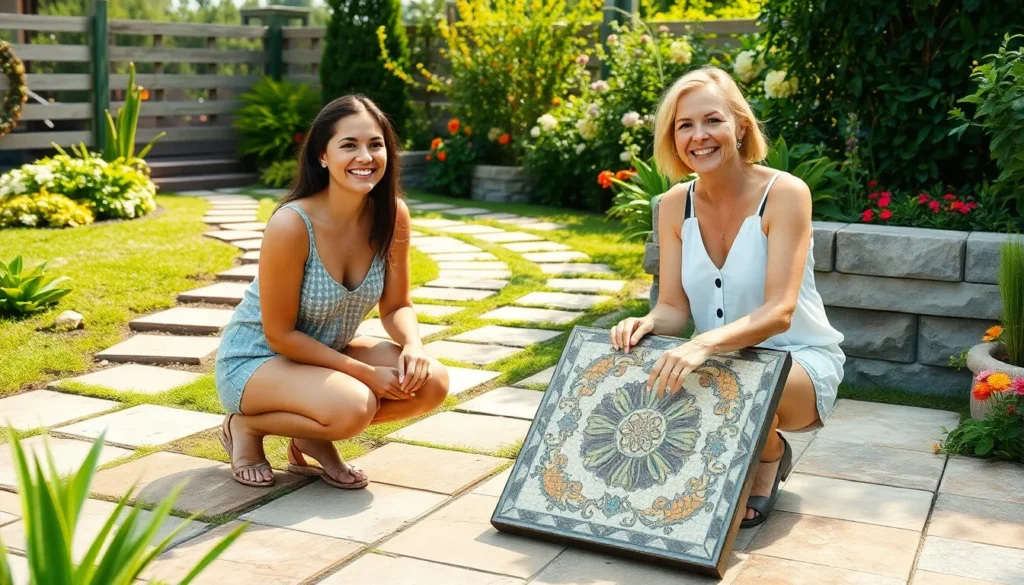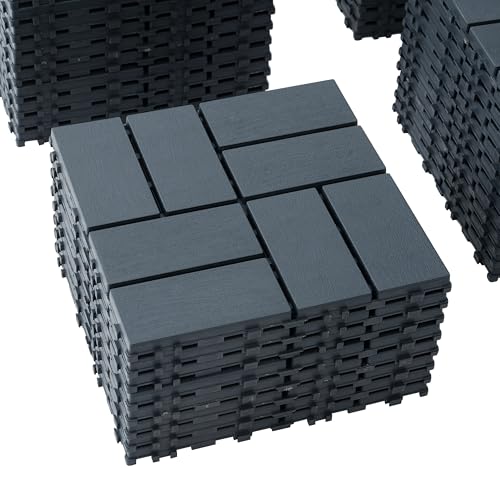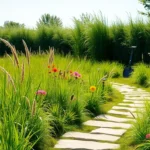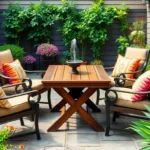We’re about to transform your outdoor space into something extraordinary with creative garden tile ideas that’ll make your neighbors stop and stare. Whether you’re working with a small patio or an expansive backyard, the right tiles can completely revolutionize your garden’s look and functionality.
From sleek modern porcelain to rustic natural stone, garden tiles offer endless possibilities for creating stunning pathways, accent walls, and entertainment areas that withstand the elements. We’ve discovered that strategic tile placement doesn’t just enhance visual appeal – it also reduces maintenance while increasing your property value.
Ready to explore game-changing designs that’ll elevate your outdoor living experience? We’re diving into innovative patterns, material combinations, and budget-friendly answers that work for every style and space. Let’s turn your garden into the ultimate outdoor sanctuary you’ve always dreamed of having.
Natural Stone Garden Tiles for Timeless Elegance
Natural stone tiles bring authentic beauty and lasting value to outdoor spaces. These materials create sophisticated garden areas that blend seamlessly with nature while standing the test of time.
Slate Tiles for Rustic Pathways
Slate tiles transform ordinary walkways into stunning rustic pathways that complement any garden style. We recommend choosing darker slate varieties like Welsh slate or Vermont slate for high-traffic areas, as they hide dirt better and provide excellent slip resistance. These tiles naturally weather to develop character over time, making each pathway unique.
Installation becomes straightforward when you select slate tiles between 12-24 inches for optimal stability. Irregular slate pieces create organic-looking paths that curve naturally through garden beds, while uniform rectangular slates work perfectly for formal geometric designs. The natural texture provides excellent grip even when wet, making slate an ideal choice for areas near water features or irrigation systems.
Maintenance requirements stay minimal with slate pathways since the material resists staining and requires only occasional pressure washing. Colors range from deep charcoal and blue-gray to warmer earth tones, allowing you to match your home’s exterior or create striking contrast with surrounding plantings.
Travertine Options for Pool Areas
Travertine tiles excel in pool environments due to their natural cooling properties and slip-resistant surface texture. We’ve found that tumbled travertine provides the best combination of safety and comfort for bare feet, while maintaining the elegant appearance that makes these tiles so popular. The stone’s porous nature allows water to drain quickly, reducing puddles and slip hazards around pool decks.
Colors typically include warm beiges, soft ivory, and rich gold tones that complement water features beautifully. Premium travertine options like Turkish or Italian varieties offer superior durability and consistent coloring, though domestic alternatives can provide excellent value for budget-conscious projects.
Sealing travertine tiles every 2-3 years protects against chlorine damage and staining while preserving the natural beauty. The stone stays cool underfoot even in direct sunlight, making it comfortable for pool activities throughout the day. Edge treatments around pool coping require special attention to ensure proper drainage and safety compliance.
Flagstone Designs for Patio Spaces
Flagstone tiles create versatile patio designs that accommodate both casual family gatherings and elegant entertaining spaces. We typically recommend Pennsylvania bluestone or Arizona flagstone for their durability and wide color range, though local stone varieties often provide the best value and regional aesthetic appeal.
Large format flagstones measuring 2-4 feet work excellently for spacious patios, while smaller 12-18 inch pieces suit compact areas or detailed accent work. Irregular shapes allow for creative puzzle-like installations that maximize natural beauty, whereas cut rectangular pieces provide clean lines for contemporary designs.
Joint spacing between flagstones can accommodate various design preferences, from tight mortar joints for formal appearances to wide gaps filled with moss or small plants for cottage garden styles. The natural variation in thickness requires careful leveling during installation but results in authentic texture that manufactured tiles cannot replicate.
Weathering characteristics vary by stone type, with some flagstones developing attractive patina over time while others maintain consistent coloring for decades.
Ceramic and Porcelain Garden Tiles for Durability
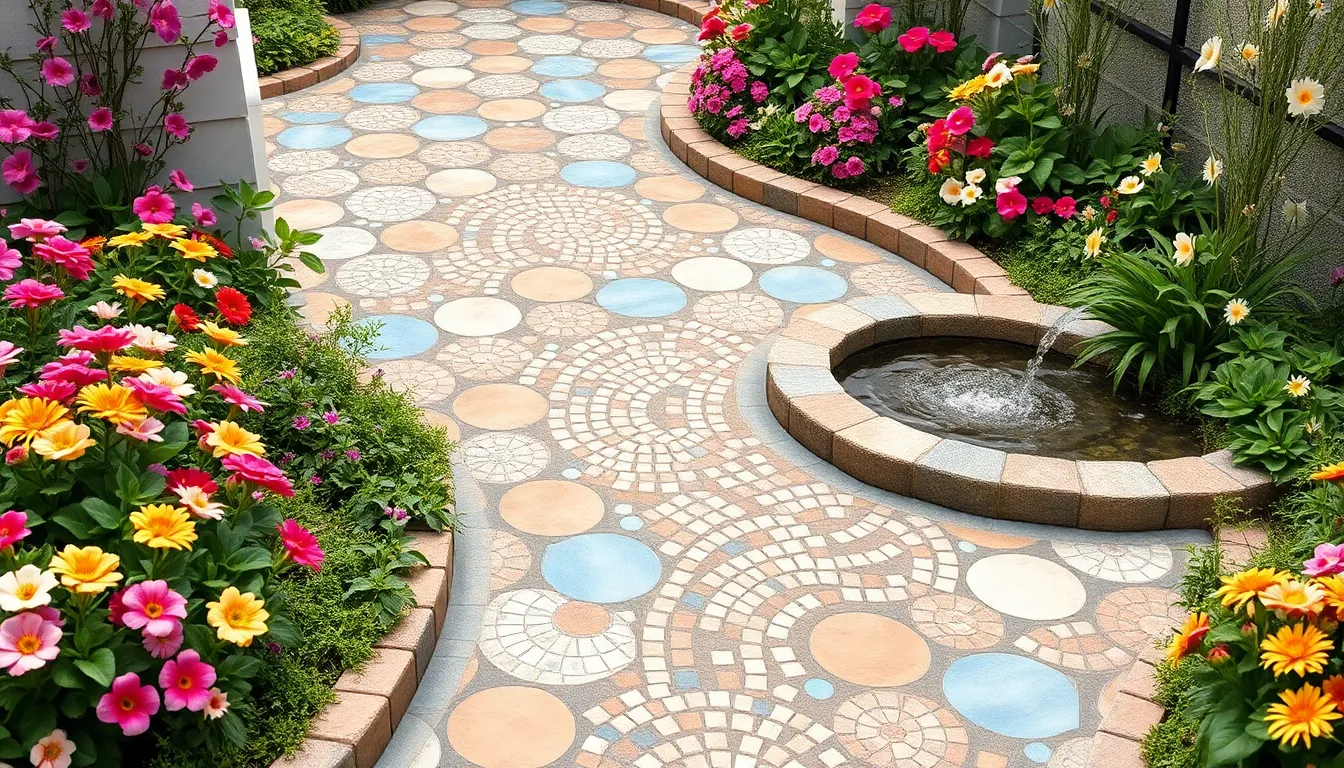
Building on the natural stone options we’ve explored, ceramic and porcelain tiles offer exceptional durability and design flexibility for modern outdoor spaces. Porcelain tiles outperform ceramic tiles in durability due to their dense composition, making them ideal for high-traffic areas and harsh outdoor conditions with a porosity level of less than 0.5%.
Weather-Resistant Porcelain Collections
Porcelain tiles excel in outdoor environments because they’re highly resistant to UV fading and can withstand extreme temperatures without swelling or cracking. Modern collections like Porcea Amalfi showcase how porcelain tiles can mimic natural stone while delivering superior weather resistance for garden paths and patios.
These collections work particularly well in areas with heavy foot traffic and extreme weather conditions where traditional materials might fail. We recommend porcelain for spaces that experience frequent temperature fluctuations or intense sun exposure throughout the year.
Decorative Ceramic Mosaic Patterns
Ceramic tiles create stunning decorative mosaic patterns that add visual interest to garden areas through small, colored tiles arranged in intricate designs. These mosaics offer unlimited creative possibilities for improving garden aesthetics while maintaining durability.
Design flexibility becomes a major advantage when working with ceramic mosaics, allowing us to incorporate various colors, textures, and patterns into garden layouts. We can use these decorative elements as accent features on walls, stepping stones, or focal points within larger tile installations.
Anti-Slip Surface Options
Both ceramic and porcelain tiles can be treated with anti-slip coatings or textured finishes to enhance traction and reduce slipping risks in wet conditions. Safety becomes crucial for outdoor areas, especially around pools or water features where moisture creates hazardous walking surfaces.
Textured finishes provide the best combination of safety and aesthetics for garden tile installations. We recommend these anti-slip options for any outdoor space where water exposure is common or where family members and guests will be walking frequently.
Wood-Look Garden Tiles for Warmth and Character
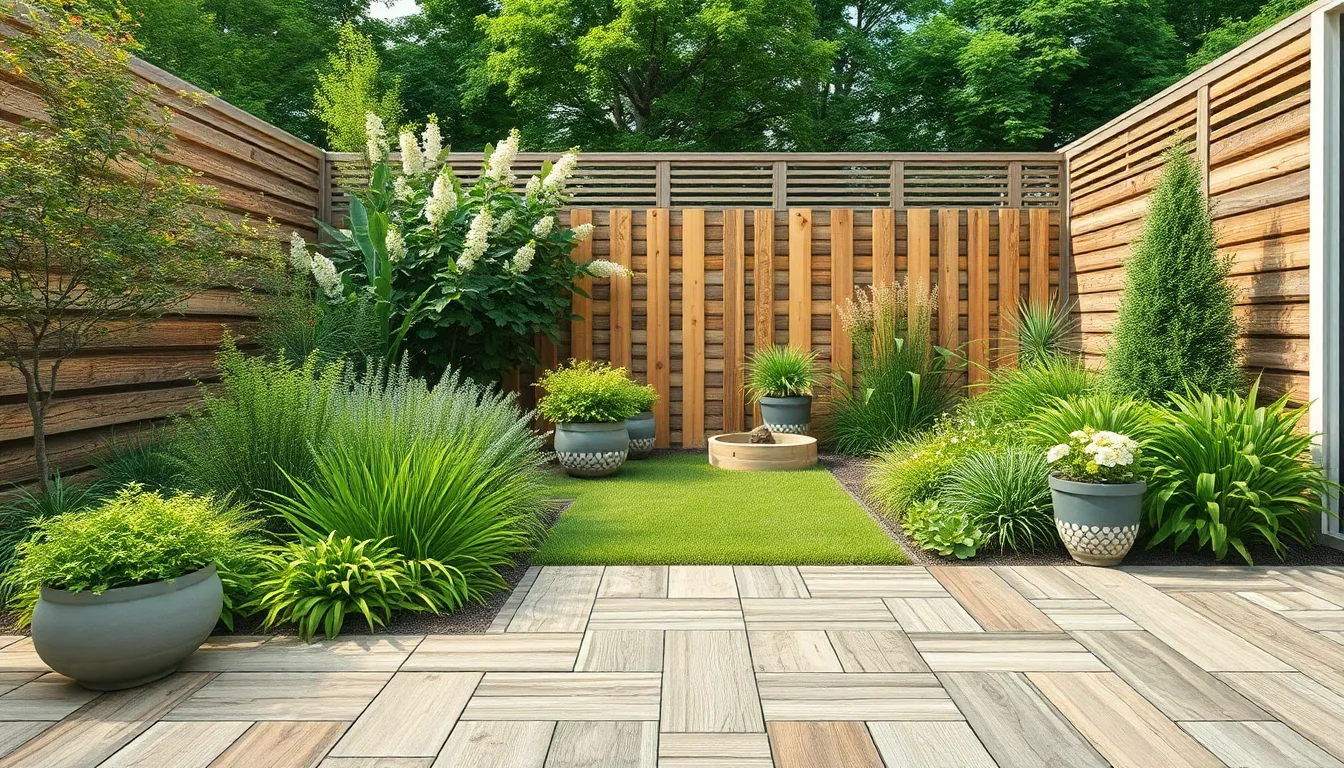
We’re moving beyond traditional materials to explore wood inspired garden tiles that deliver natural aesthetics without the maintenance challenges. These innovative options bring the cozy appeal of timber to our outdoor spaces while offering superior durability and weather resistance.
Composite Decking Tile Alternatives
Composite decking tiles combine wood fibers with plastic materials to create exceptionally durable outdoor surfaces. We recommend these tiles for high traffic garden areas where traditional wood would require frequent maintenance. Installation becomes straightforward with interlocking systems that allow us to create seamless decking surfaces over existing concrete or dirt foundations.
Manufacturers design these composite options to resist fading, staining, and moisture damage that typically affects natural wood. We’ll find composite tiles in various wood grain patterns including oak, cedar, and teak finishes that maintain their appearance for decades. Maintenance requirements drop significantly compared to traditional decking since these tiles never need staining or sealing treatments.
Bamboo-Style Tile Designs
Bamboo style tiles offer eco friendly aesthetics with natural earthy tones that complement garden landscapes beautifully. We can select from porcelain and ceramic tiles that replicate bamboo’s distinctive vertical grain patterns and warm honey colors. These sustainable design choices work particularly well in contemporary garden settings where we want to emphasize environmental consciousness.
Modern manufacturing techniques allow bamboo inspired tiles to capture the subtle texture variations found in real bamboo flooring. We appreciate how these tiles provide slip resistant surfaces that perform well around water features and pool areas. Color options range from light natural bamboo to deeper caramelized tones that add richness to outdoor entertaining spaces.
Reclaimed Wood Effect Options
Reclaimed wood effect tiles replicate the character and patina of weathered timber without the structural concerns of actual recycled materials. We choose these tiles when designing rustic garden themes that celebrate vintage charm and distressed finishes. Porcelain manufacturers excel at creating realistic weathering effects including nail holes, saw marks, and natural aging patterns.
These tile options deliver authentic reclaimed aesthetics while providing consistent sizing and installation properties that real salvaged wood cannot match. We find reclaimed wood effect tiles particularly effective for creating accent walls, pathway borders, and outdoor kitchen backsplashes. Surface textures range from smooth worn finishes to more pronounced grain patterns that add tactile interest to garden designs.
Geometric Pattern Garden Tiles for Modern Appeal
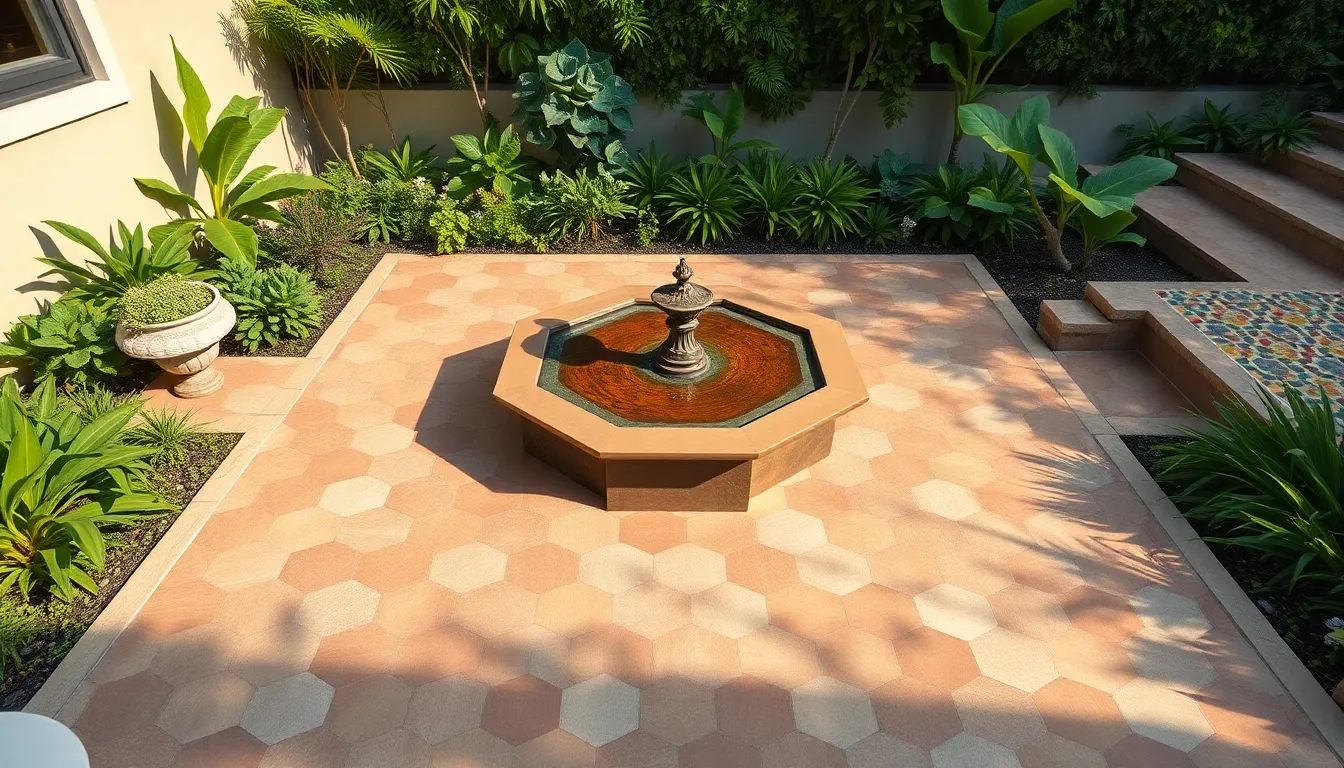
We’re seeing geometric patterns transform outdoor spaces with their bold, architectural appeal that perfectly complements contemporary garden designs. These structured patterns create visual interest while maintaining the clean, sophisticated aesthetic that modern homeowners desire.
Hexagonal Tile Arrangements
Hexagonal patterns deliver maximum visual impact through their naturally occurring honeycomb structure that’s both pleasing to the eye and highly functional. We recommend porcelain hexagons for their exceptional durability and low maintenance requirements, making them perfect for high traffic pathways and patio areas.
Installation becomes straightforward when you choose hexagonal tiles that interlock seamlessly, creating continuous patterns without awkward cuts or complex layouts. These arrangements work particularly well for defining different zones in your garden, from dining areas to walkways.
Porcelain hexagon tiles resist weathering and maintain their appearance through extreme temperature changes, ensuring your geometric patterns stay sharp and defined year after year.
Moroccan-Inspired Geometric Designs
Moroccan mosaic tiles bring centuries of artistic tradition to modern gardens through their intricate geometric shapes and vibrant color combinations. We love how these abstract geometric patterns, inspired by classic Islamic garden designs, create focal points that draw the eye and spark conversation.
Color selection becomes crucial when working with Moroccan inspired designs, as the traditional blues, greens, and earth tones can either complement or contrast with your existing industry elements. These tiles work exceptionally well as accent features around water features or as decorative borders.
Cultural authenticity emerges through the use of traditional geometric motifs that have been refined over generations, bringing depth and storytelling to your outdoor space.
Contemporary Linear Patterns
Linear mosaics create striking modern aesthetics through their clean lines and rectangular arrangements that emphasize direction and flow within your garden design. We find these patterns particularly effective for creating pathways that guide visitors through different areas of your outdoor space.
Contemporary patio tiles like elevated diamond designs offer creative hardscape answers that work beautifully in drought friendly and low maintenance garden settings. These geometric arrangements require minimal upkeep while delivering maximum visual impact.
Straight line arrangements provide versatility in design applications, allowing you to create everything from subtle accent strips to bold statement walls that define your outdoor living areas.
Permeable Garden Tiles for Eco-Friendly Solutions
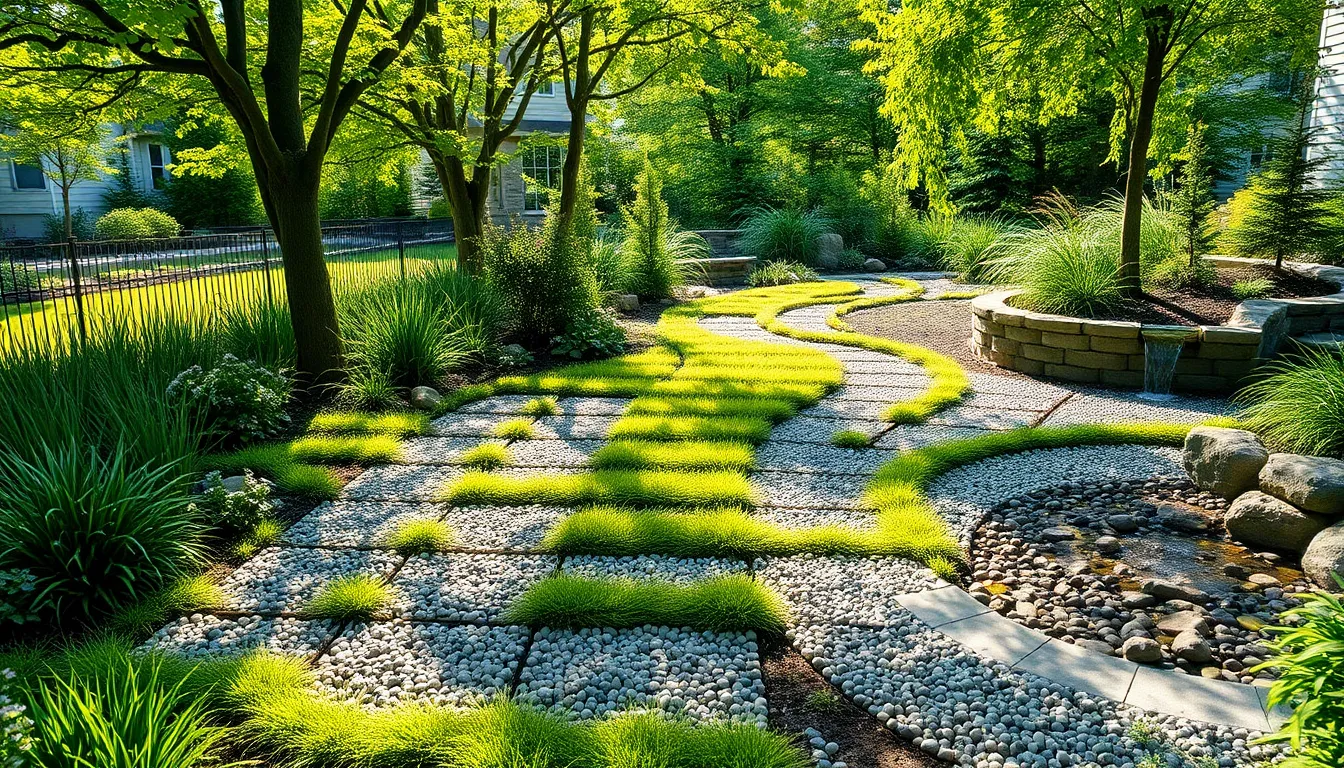
Moving beyond aesthetic appeal, we’re embracing sustainable garden tile answers that actively benefit our environment. These innovative permeable options transform our outdoor spaces while addressing critical environmental challenges like stormwater management and urban heat reduction.
Grass Grid Paver Systems
Grass grid paver systems combine structural strength with natural beauty, allowing vegetation to flourish while providing durable surfaces for foot traffic and light vehicles. These innovative tiles feature open cells that support healthy grass growth, creating living surfaces that control erosion and reduce runoff effectively.
Installation proves straightforward as the grid structure provides excellent load distribution across various soil types. We recommend choosing high-density polyethylene grids for maximum durability, especially in areas experiencing temperature fluctuations.
Maintenance remains minimal since the grass naturally filters rainwater while the grid prevents soil compaction. Root development thrives within these systems, promoting sustainable drainage that reduces our reliance on traditional stormwater infrastructure.
Gravel-Filled Permeable Options
Gravel-filled permeable tiles offer exceptional drainage efficiency while maintaining attractive, low-maintenance surfaces perfect for contemporary garden designs. Water seeps through strategically placed joints, infiltrating soil naturally and filtering pollutants like oil and rubber before they reach waterways.
Design flexibility allows us to choose from various gravel colors and sizes, creating unique textures that complement existing industry elements. Larger aggregate sizes provide better drainage rates, while smaller stones offer more refined appearances for formal garden settings.
Installation requires proper base preparation with graduated layers of different aggregate sizes to ensure optimal water flow. We’ve found that incorporating geotextile fabric beneath the base prevents soil migration while maintaining long-term permeability.
Water Management Benefits
Aquifer recharge represents one of the most important advantages of permeable garden tiles, as they allow rainwater to naturally replenish groundwater supplies rather than overwhelming municipal drainage systems. Studies show these systems can reduce stormwater runoff by up to 80% compared to traditional impervious surfaces.
Temperature regulation occurs naturally as permeable surfaces absorb less heat than conventional pavement, reducing surrounding air temperatures and minimizing cooling costs for nearby buildings. This cooling effect helps combat urban heat island effects that plague many residential areas.
Pollution reduction happens automatically as rainwater filters through permeable materials, trapping contaminants before they enter our water systems. The natural filtration process removes sediments, oils, and other pollutants while simultaneously reducing the energy required for municipal water treatment facilities.
Interlocking Garden Tiles for Easy Installation
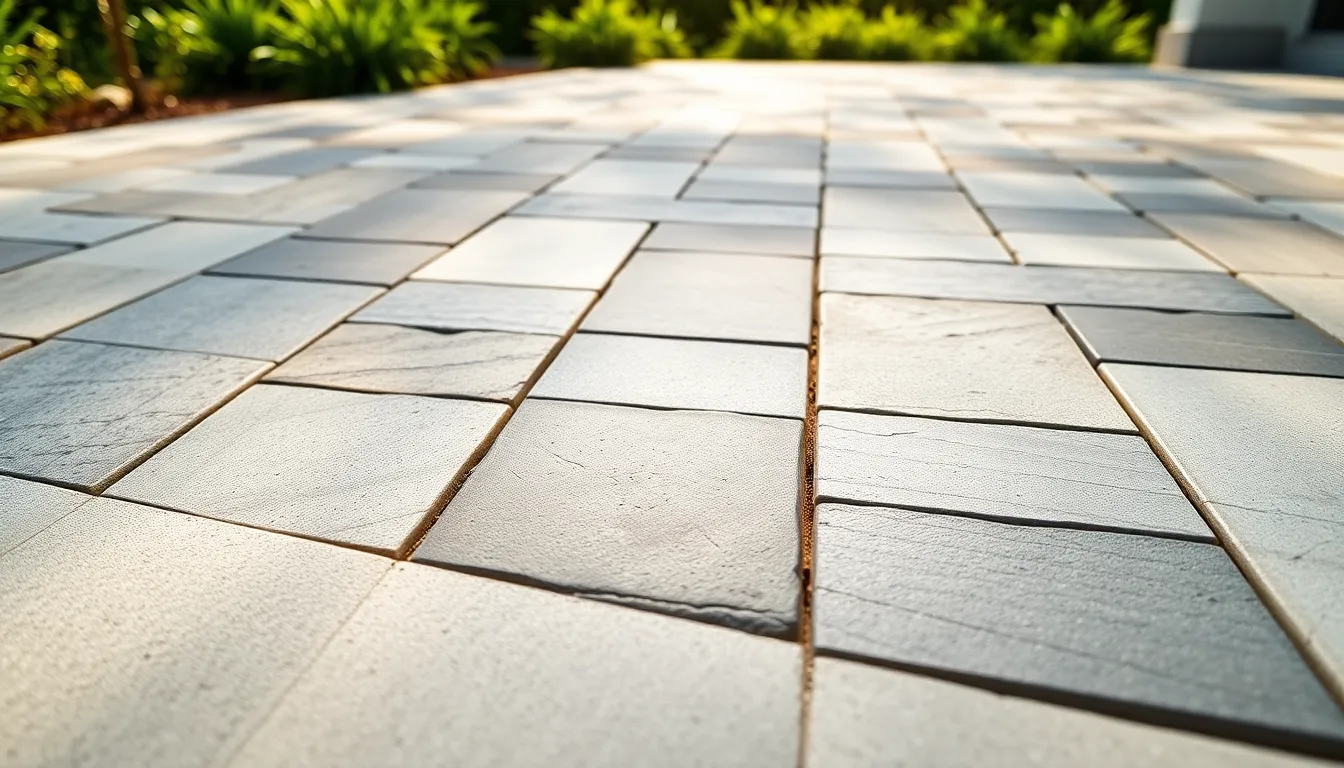
Interlocking garden tiles revolutionize outdoor space design with their innovative dovetail joint systems that snap together effortlessly. We’ve found these tiles offer unmatched versatility for both permanent installations and temporary garden transformations.
Snap-Together Deck Tiles
Snap-together deck tiles feature four-way interlocking mechanisms that create endless design possibilities for your outdoor spaces. We appreciate how these tiles connect without requiring adhesives or permanent attachments, making them perfect for renters or seasonal installations.
Design flexibility becomes your greatest advantage with these versatile tiles, allowing you to change patterns and directions based on your aesthetic preferences. Installation requires minimal tools, typically just a rubber mallet and measuring tape, making them ideal for weekend DIY projects. We recommend starting with a small area to test your pattern before committing to the entire space.
Surface compatibility extends to concrete, brick, wood, and even properly prepared grass areas, giving you freedom to transform virtually any outdoor surface. Coverage efficiency improves significantly since these tiles eliminate gaps and create seamless transitions between different areas of your garden.
Modular Stone Tile Systems
Modular stone tile systems deliver the authentic beauty of natural stone with the convenience of modern engineering. We’ve discovered these systems excel in durability, withstanding harsh weather conditions while maintaining their aesthetic appeal year after year.
Pattern versatility allows you to create unique garden designs that reflect your personal style, from classic brick layouts to contemporary geometric arrangements. Stone variety includes options like travertine, slate, and limestone, each offering distinct textures and color palettes for your outdoor sanctuary.
Eco-friendly options incorporate recycled stone materials, appealing to environmentally conscious homeowners who want sustainable garden answers. We particularly recommend these systems for high-traffic areas where durability and visual impact are equally important. Installation simplicity matches traditional interlocking tiles while providing the premium look of custom stonework.
DIY-Friendly Installation Methods
DIY installation begins with proper surface preparation, ensuring your foundation is level and smooth before laying any tiles. We always recommend checking for drainage issues and addressing them before starting your project.
Starting technique involves beginning in a corner and working outward to maintain proper alignment and prevent unsightly gaps. Grass installations require additional preparation, including laying plywood or similar base materials to create stability and prevent settling.
| Installation Step | Time Required | Tools Needed |
|---|---|---|
| Surface preparation | 2-4 hours | Level, rake, compactor |
| Layout planning | 1 hour | Measuring tape, chalk |
| Tile installation | 4-8 hours | Rubber mallet, spacers |
| Final adjustments | 1-2 hours | Level, additional base material |
Alignment checks throughout the installation process help maintain professional results and prevent costly mistakes. We suggest installing tiles in small sections, checking for level every few rows and adjusting the ground as necessary. Quality control involves testing each connection point to ensure tiles lock securely together, creating a stable surface that will last for years.
Decorative Accent Garden Tiles for Visual Interest
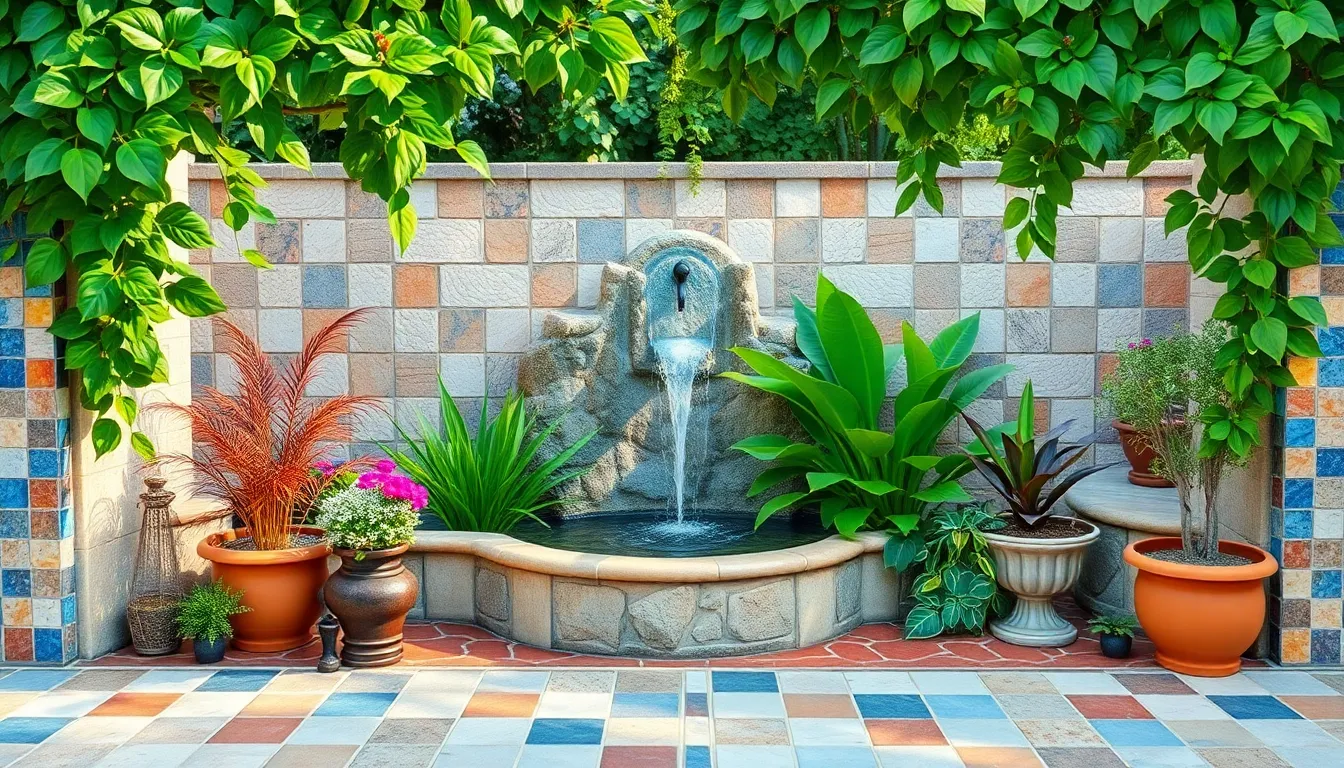
Adding decorative accent tiles transforms ordinary outdoor spaces into stunning focal points that capture attention and create lasting impressions. These specialized tiles serve as the jewelry of garden design, bringing personality and artistic flair to otherwise basic surfaces.
Colorful Mosaic Border Tiles
Mosaic border tiles create vibrant frames around garden beds, pathways, and water features with their intricate color combinations. We’ve seen these tiles arranged in traditional Mediterranean patterns, contemporary geometric designs, and nature-inspired motifs that complement surrounding plantings perfectly.
Various colors blend seamlessly together in mosaic arrangements, allowing you to match existing industry palettes or create bold contrasting statements. Installing these tiles along raised bed edges creates defined boundaries while adding visual depth to your garden’s overall composition.
Multiple installation patterns work beautifully for mosaic borders, including running bond layouts for streamlined looks and random patterns for artistic expressions. These versatile tiles adapt to curved edges and irregular shapes, making them ideal for organic garden designs that flow naturally through outdoor spaces.
Hand-Painted Artistic Options
Hand-painted accent tiles provide personalized touches that reflect your unique style and garden theme preferences. Armenian Ceramics specializes in custom hand-painted designs that can incorporate exact botanical elements, cultural motifs, or abstract patterns customized to your outdoor environment.
Customization options include matching existing architectural features, incorporating family symbols, or creating seasonal themes that change throughout the year. Artists can paint individual tiles with garden-exact imagery like local flora, wildlife, or industry elements that connect your outdoor space to its natural surroundings.
Durability remains excellent with properly sealed hand-painted tiles, ensuring your artistic investment withstands weather exposure while maintaining vibrant colors. Professional installation helps protect these unique pieces while positioning them strategically for maximum visual impact in high-visibility garden areas.
Mixed Material Combinations
Combining ceramic tiles with natural stone creates ever-changing textural contrasts that add depth and visual complexity to garden surfaces. We’ve found that pairing smooth porcelain accents with rough-hewn flagstone produces particularly striking results in contemporary industry designs.
Wood-look tiles blend beautifully with actual timber elements, creating seamless transitions between different outdoor zones while maintaining consistent maintenance requirements. This combination works especially well in deck transition areas where natural and manufactured materials need to complement each other harmoniously.
Metal accent strips paired with ceramic or stone tiles create modern industrial aesthetics that suit urban gardens and contemporary architectural styles. These mixed installations require careful planning for expansion joints and material compatibility, but they deliver sophisticated results that elevate standard tile installations into design statements.
Budget-Friendly Garden Tiles for Cost-Conscious Projects
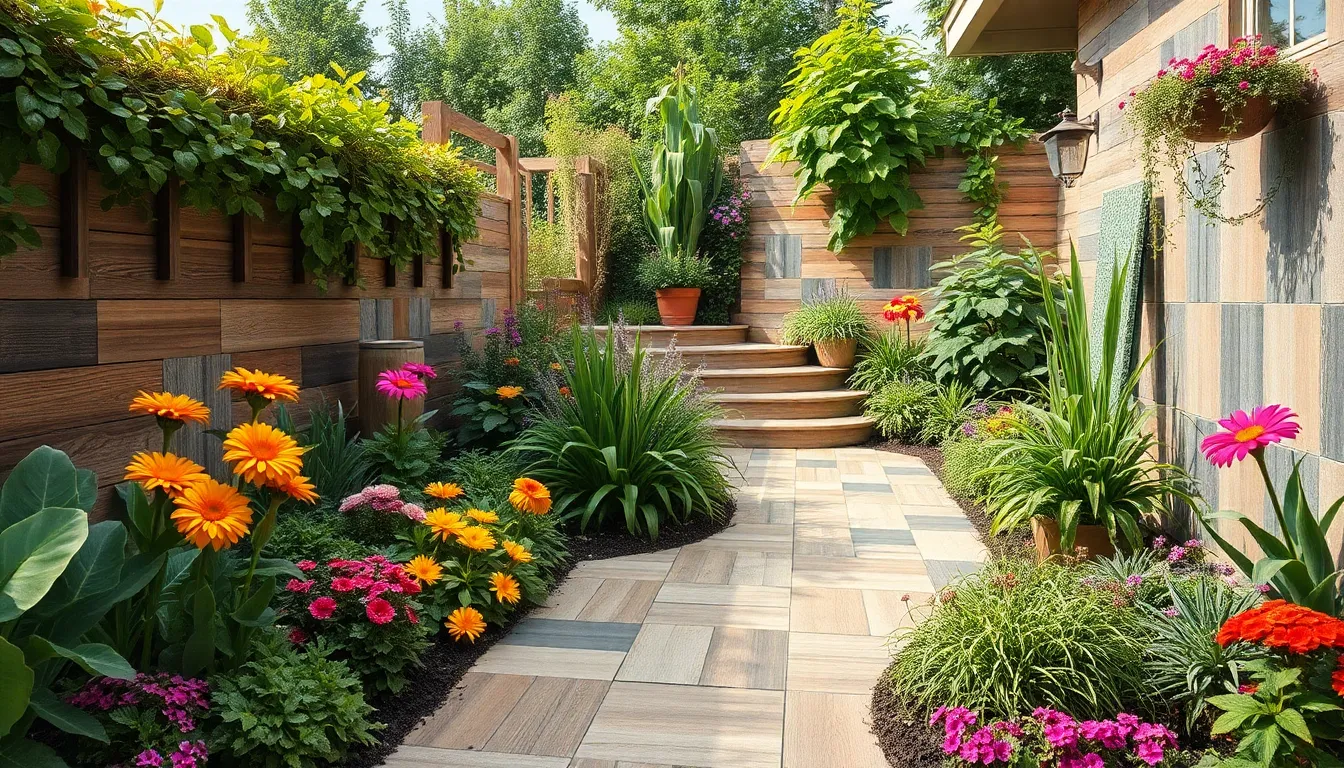
Creating stunning outdoor spaces doesn’t require draining your savings account. Smart material choices and strategic planning can deliver professional results while keeping costs manageable.
Concrete Tile Alternatives
Wood composite tiles offer the warm aesthetics of natural timber without the premium price tag. These eco-friendly options mimic authentic wood grain patterns while providing superior durability against weather and wear. Installation becomes straightforward since most composite tiles feature interlocking systems that eliminate the need for professional contractors.
Porcelain tiles deliver exceptional value through their versatility and longevity. Available in countless styles including stone, wood, and concrete looks, these tiles often cost 30-50% less than their natural counterparts. Anti-slip coatings make them particularly suitable for pool areas and high-traffic zones where safety matters most.
Standard concrete pavers remain one of the most economical choices for large coverage areas. Their uniform appearance creates clean, modern aesthetics while their durability ensures decades of performance with minimal maintenance requirements.
Recycled Material Options
Recycled glass tiles transform waste materials into stunning garden features at fraction of new tile costs. These environmentally conscious options add vibrant colors and reflective qualities that can brighten shaded garden areas. Manufacturing processes using recycled content typically reduce prices by 20-40% compared to virgin materials.
Recycled ceramic tiles provide excellent opportunities for creative mosaic projects and decorative accents. Salvage yards and renovation surplus stores often stock these materials at important discounts. Broken or chipped pieces work perfectly for artistic installations where imperfection adds character.
Reclaimed brick and stone offer authentic vintage appeal while supporting sustainable building practices. These materials often cost less than new alternatives and bring unique patina that new products can’t replicate.
Large Format Tiles for Coverage
Reduced grout lines make spaces appear larger while minimizing cleaning and maintenance requirements. Large format tiles measuring 24×24 inches or bigger can cover the same area with 75% fewer individual pieces than standard sizes.
Installation efficiency translates directly into labor savings whether you’re hiring professionals or tackling the project yourself. Fewer tiles mean fewer cuts, less adhesive, and reduced installation time. Professional installers often charge by square footage, making large tiles particularly cost effective for extensive coverage areas.
Seamless appearance creates sophisticated looks that rival expensive natural stone installations. Large porcelain slabs can mimic marble, granite, or concrete surfaces while offering superior stain resistance and easier maintenance than their natural counterparts.
Maintenance Tips for Long-Lasting Garden Tiles
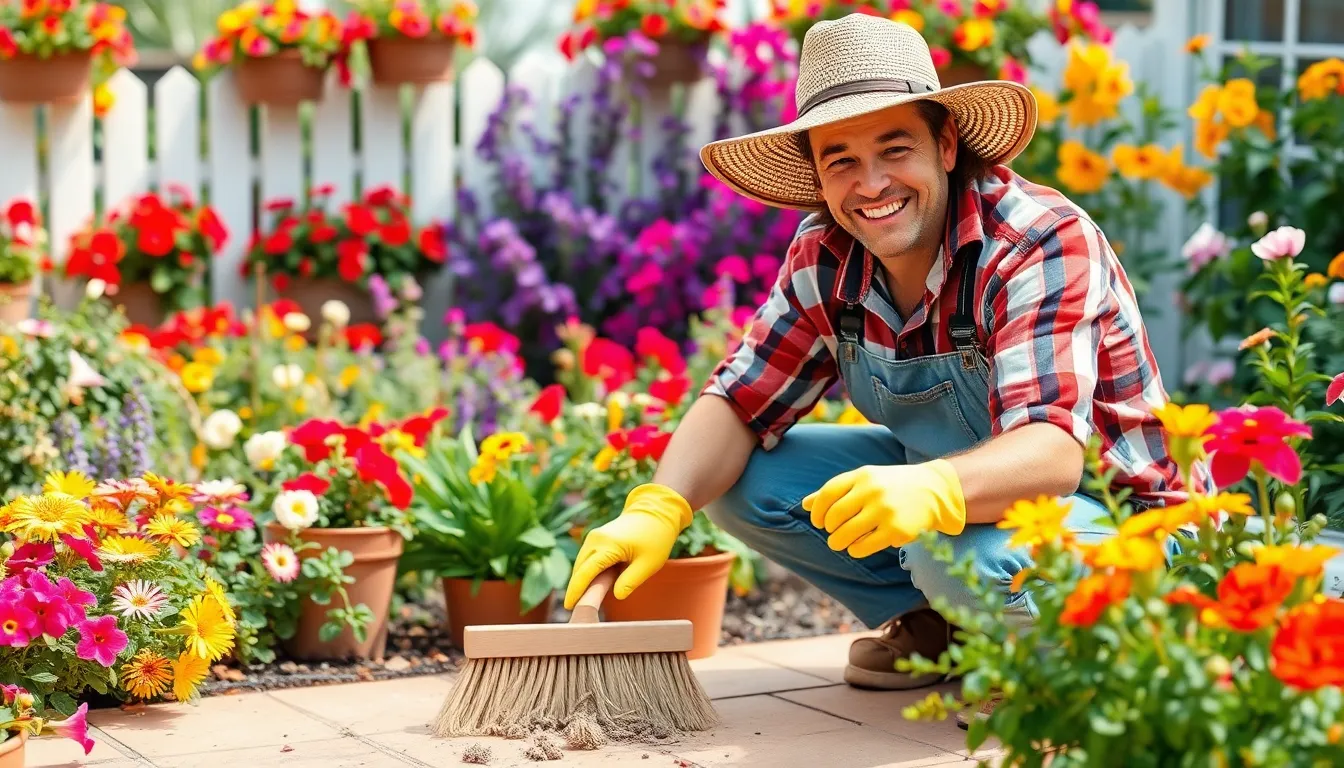
Proper maintenance ensures your garden tiles retain their beauty and functionality for years to come. We’ll guide you through essential care practices that protect your investment and keep your outdoor space looking pristine.
Cleaning and Sealing Requirements
Weekly cleaning forms the foundation of effective tile maintenance. We recommend sweeping or vacuuming debris from tile surfaces every week, followed by washing with mild detergent and water to remove dirt buildup.
Monthly deep cleaning becomes necessary for stubborn stains and accumulated grime. Specialized cleaners work best for tough spots that regular washing can’t handle, ensuring your tiles maintain their original appearance.
Sealant application protects tiles from environmental damage throughout the seasons. We apply sealant as needed based on tile material and exposure levels, creating a protective barrier against moisture, UV rays, and temperature fluctuations.
| Maintenance Task | Frequency | Method |
|---|---|---|
| Surface Cleaning | Weekly | Sweep/vacuum + mild detergent wash |
| Deep Cleaning | Monthly | Specialized cleaners for stains |
| Sealing | As needed | Environmental protection sealant |
Seasonal Care Considerations
Winter preparation prevents costly damage from freezing temperatures and snow accumulation. We ensure proper drainage systems function correctly and promptly clear snow to prevent ice formation that can crack tiles.
Summer monitoring helps us identify heat related damage before it becomes severe. Heavy use periods during warm months require more frequent cleaning to maintain both appearance and safety standards.
Rainy season inspections catch moss and mold growth early in the development process. Pressure washing becomes our go to solution for maintaining cleanliness and preventing slip hazards during wet weather conditions.
Repair and Replacement Guidelines
Immediate crack repair stops small problems from becoming major structural issues. We address any visible damage as soon as we notice it, preventing water infiltration and further deterioration.
Strategic tile replacement maintains both aesthetic appeal and structural integrity across the entire garden area. Damaged tiles compromise the overall appearance and can create safety hazards if left unaddressed.
Prevention focused approach saves time and money compared to reactive repairs. We choose tiles suitable for our exact climate conditions and install proper drainage systems to minimize future maintenance needs.
Weed and moss prevention requires sealing gaps between tiles and installing weed barriers where appropriate. These proactive measures reduce long term maintenance while preserving the clean appearance of our garden tile installation.
Conclusion
Garden tiles offer endless possibilities to transform your outdoor space into a stunning sanctuary that reflects your personal style. Whether you’re drawn to the timeless elegance of natural stone or the modern appeal of geometric patterns these versatile materials can elevate any garden design.
We’ve explored budget-friendly options that prove beautiful doesn’t have to mean expensive alongside eco-friendly answers that benefit both your space and the environment. From interlocking systems perfect for DIY enthusiasts to decorative accents that create striking focal points there’s a tile solution for every vision and skill level.
Remember that proper maintenance ensures your investment continues to enhance your property for years to come. With the right combination of materials patterns and care your garden tiles will create an outdoor oasis that impresses guests and provides lasting enjoyment for your family.
Frequently Asked Questions
What are the best types of garden tiles for outdoor spaces?
The best garden tiles include natural stone (slate, travertine, flagstone), porcelain, ceramic, wood-look composite tiles, and permeable options. Natural stone offers timeless elegance, while porcelain provides superior durability and weather resistance. Wood-look tiles give timber aesthetics without maintenance issues, and permeable tiles help with water management and environmental sustainability.
How do I choose between natural stone and ceramic tiles for my garden?
Natural stone tiles like slate and travertine offer authentic beauty and blend seamlessly with nature but require sealing and more maintenance. Ceramic and porcelain tiles provide better durability, weather resistance, and are 30-50% less expensive than natural stone. Choose based on your budget, maintenance preferences, and desired aesthetic.
Are permeable garden tiles worth the investment?
Yes, permeable garden tiles offer excellent long-term value. They manage stormwater runoff, reduce urban heat, help with pollution reduction, and support aquifer recharge. Grass grid pavers and gravel-filled options provide drainage efficiency while maintaining durability, making them ideal for environmentally conscious homeowners seeking sustainable outdoor solutions.
What’s the easiest way to install garden tiles myself?
Interlocking tiles with snap-together or dovetail joint systems are the easiest for DIY installation. Focus on proper surface preparation, ensure level ground, and check alignment regularly. Modular systems require no special tools and can be easily removed or reconfigured, making them perfect for renters or temporary installations.
How can I create stunning garden tile designs on a budget?
Use concrete alternatives, recycled materials, and large format tiles to reduce costs. Wood composite tiles mimic natural timber affordably, while recycled glass and ceramic add vibrant colors economically. Large format tiles reduce installation time and grout lines, offering sophisticated looks while being cost-effective for extensive coverage areas.
How often should I maintain my garden tiles?
Follow a maintenance schedule: weekly cleaning, monthly deep cleaning for stains, and seasonal sealant application based on material type. Inspect for cracks immediately and replace damaged tiles promptly. Winter preparation prevents freeze damage, while summer monitoring addresses heat-related issues. Proper maintenance extends tile lifespan significantly.
Can I mix different tile materials in my garden design?
Absolutely! Mixed material combinations create sophisticated designs with textural contrast. Popular pairings include ceramic with natural stone, wood-look tiles with porcelain, and mosaic accents with solid tiles. This approach ensures seamless transitions between outdoor zones while elevating overall aesthetic appeal and allowing for creative personalization.
What are geometric pattern tiles and how do they enhance gardens?
Geometric pattern tiles feature bold, architectural designs like hexagonal arrangements, Moroccan-inspired patterns, and linear layouts. They create visual impact, guide traffic flow, and add contemporary appeal to outdoor spaces. Hexagonal porcelain tiles offer durability and easy installation, while linear patterns emphasize direction and require minimal upkeep.

